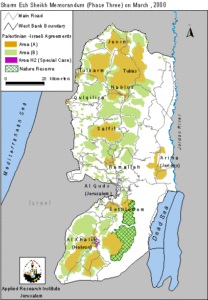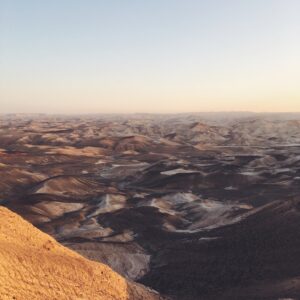Learn ABOUT
The West Bank
Churches for Middle East Peace (CMEP) opposes the severe limitations on Palestinian self-determination, freedom of movement, and economic activity posed by settlement expansion.

As of 2015, the territory lying between the 1948 Armistice Line (Green Line) and the Jordan River has a population of three million, including nearly 400,000 Israeli settlers. According to the 1947 UN Partition Plan, the West Bank was to become part of an Arab state. However after the 1948 Arab-Israeli War, the West Bank was annexed by Jordan. Israel gained control over the West Bank after defeating Jordan in the 1967 War. Since the Oslo Accords (1993-1995), the West Bank has been divided into three zones: Zone A is under Palestinian civil administration and security control; Zone B is under Palestinian civil administration and Israeli security control; Zone C is under Israeli civil administration and security control. Zones A and B exist as isolated islands in the midst of Zone C. Israel is therefore able to maintain complete control of the areas under Palestinian administration.
The presence of historical Jewish sites in the West Bank dating back to the ancient Israelite kingdoms of Judah and Samaria (900-500 BC) has motivated many Israelis to settle in the West Bank since 1967. Israeli settlements in the occupied territories violate the duties of an occupying power under Fourth Geneva Convention. The expansion of these settlements together with their network of settler-only roads and security checkpoints has hindered Palestinian development and restricted their freedom of movement.
Churches for Middle East Peace (CMEP) opposes the severe limitations on Palestinian self-determination, freedom of movement, and economic activity posed by settlement expansion. CMEP also fears that these facts on the ground are undermining the possibility of a two-state solution.
(Source: CIA World Factbook, 2017)
Population: 2,743,943
Religions: Islam: 84.5%, Judaism: 14%, Christianity: 1.5%
Israeli Settlers: 391,000
Population Below Poverty Line: 18%
Unemployment: 26.7%

Action Alert: Tell Congress: The Administration’s Peace Plan Must Address the Needs of Palestinians and Israelis. In late 2018, the Trump Administration discussed preparing to release its long-anticipated peace plan for Israel and Palestine. A small team of Trump’s advisers, led by Jared Kushner and Jason Greenblatt, have spent over a year preparing what they claim will be the most comprehensive proposal for an end to the region’s conflict ever introduced. While little is known about the details of this plan, it is clear that Palestinians do not have a seat at the table. The Administration’s recognition of Jerusalem as the capital of Israel, as well as its current attempt to use humanitarian aid as a bargaining chip, indicate that this deal will not address the needs and realities of Palestinians. Settlements and Displacement The existence and continuing expansion of illegal Israeli settlements on Palestinian lands increasingly dims the hopes and realistic prospects for a two-state solution and is a major threat to peace. Read More
Separation Barrier During the Second Intifada in 2003, Israel announced the construction of a barrier to enclose the West Bank. Many Israelis refer to the barrier as the Security Fence, while some Palestinians call it the Apartheid Wall. Only 15 percent follows the 1948 Green Line. The remainder cuts into the West Bank, incorporating Israeli settlements, separating villages from their adjoining lands, and obstructing the local economy. Because of its geographic placement, the barrier has been deemed illegal according to international law. Read More Child Detention Every year between 500 and 700 Palestinian children are tried in the West Bank under Israeli military law. Ensuring that minors receive treatment in accordance with the needs of their age within criminal justice systems is a widely accepted principle of international law. Read More
Standard of Living in West Bank is Dropping for First Time in Years, World Bank Warns [Haaretz, 2018]
“The unemployment rate in adults under 30 in the West Bank stands at 40 percent, report says; Gaza continues to hurtle towards collapse, and aid cuts to UNRWA will only exacerbate the crisis.” Read More
A Glimpse into the Life of the West Bank’s Last Christians [Haaretz, 2017]
“With a population of about 12,000, Beit Jala and the neighboring towns of Bethlehem and Beit Sahour constitute the main Christian population bloc in the West Bank – locals call it the Triangle – roughly 25,000 people…The Triangle was historically a Christian majority, but in 2007 was about 40 percent Christian and 60 percent Muslim. In Beit Jala, some 70 percent of the population was Christian in 2007, but city officials estimate the number has now dropped to 60 or 65 percent.” Read More
Planning Policy in the West Bank [B’Tselem, 2017]
“In about 70% of Area C – 42% of the West Bank – Israel has blocked Palestinian development by designating large swathes of land as state land, survey land, firing zones, nature reserves and national parks; by allocating land to settlements and their regional councils; or by introducing prohibitions to the area now trapped between the Separation Barrier and the Green Line …” Read More
Israel, Golan Heights, West Bank, and and Gaza 2017 Human Rights Report [U.S. Department of State]
NOTE: Beginning in 2017 the State Department dropped the usage of the phrase “occupied territories” from its human rights report on Israel–a decision CMEP opposed.
“The most significant human rights issues included terrorist attacks targeting civilians and politically and religiously motivated killings by nonstate groups and individuals; administrative detention of Palestinians, often extraterritorially in Israel; and legal requirements and official rhetoric that adversely affected the operating environment for human rights nongovernmental organizations (NGOs).” Read More
Israel and the Occupied Territories 2016 Human Rights Report [U.S. Department of State]
“The most significant human rights problems were terrorist attacks targeting civilians and politically and religiously motivated societal violence; institutional and societal discrimination against Arab citizens of Israel, many of whom self-identify as Palestinian…Other human rights problems included administrative detention, often extraterritorial in Israel, of Palestinians from the occupied territories; stigmatizing of human rights nongovernmental organizations (NGOs); the treatment of asylum seekers and irregular migrants; institutional and societal discrimination against non-Orthodox Jews and intermarried families; and labor rights abuses against Arab and foreign workers.” Read More
Water Scarcity Vulnerability Mapping [OCHA, 2011]
“13,723 people in 99 communities are considered at high risk of chronic water scarcity: accessing less than 30 LPCPD (litres per capita per day), often paying more than 20 NIS/cum, having not network nor adequate water storage and relying on low quality water; these communities are in Area C.” Read More
110 Maryland Ave NE #505
Washington, DC 20002